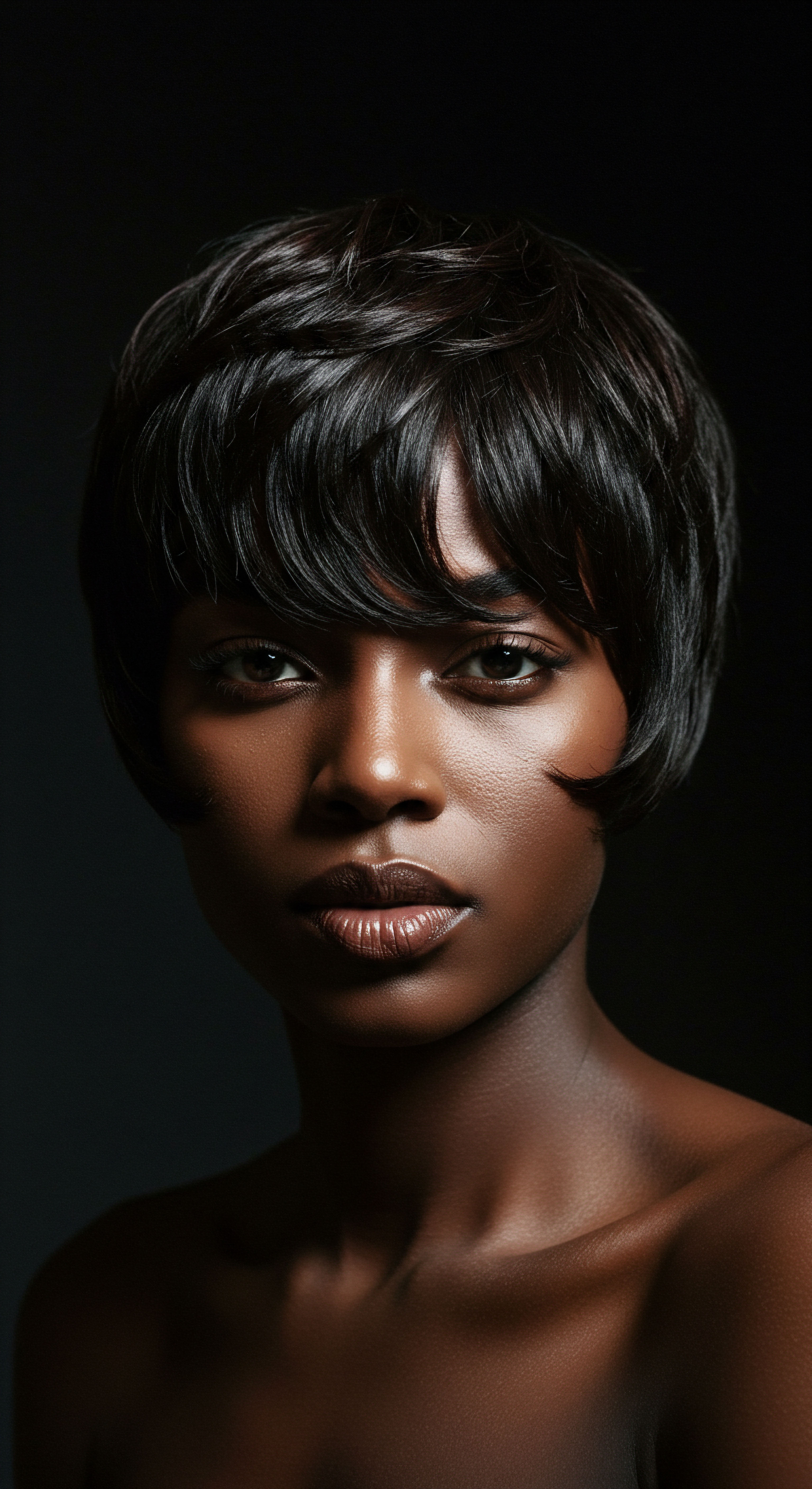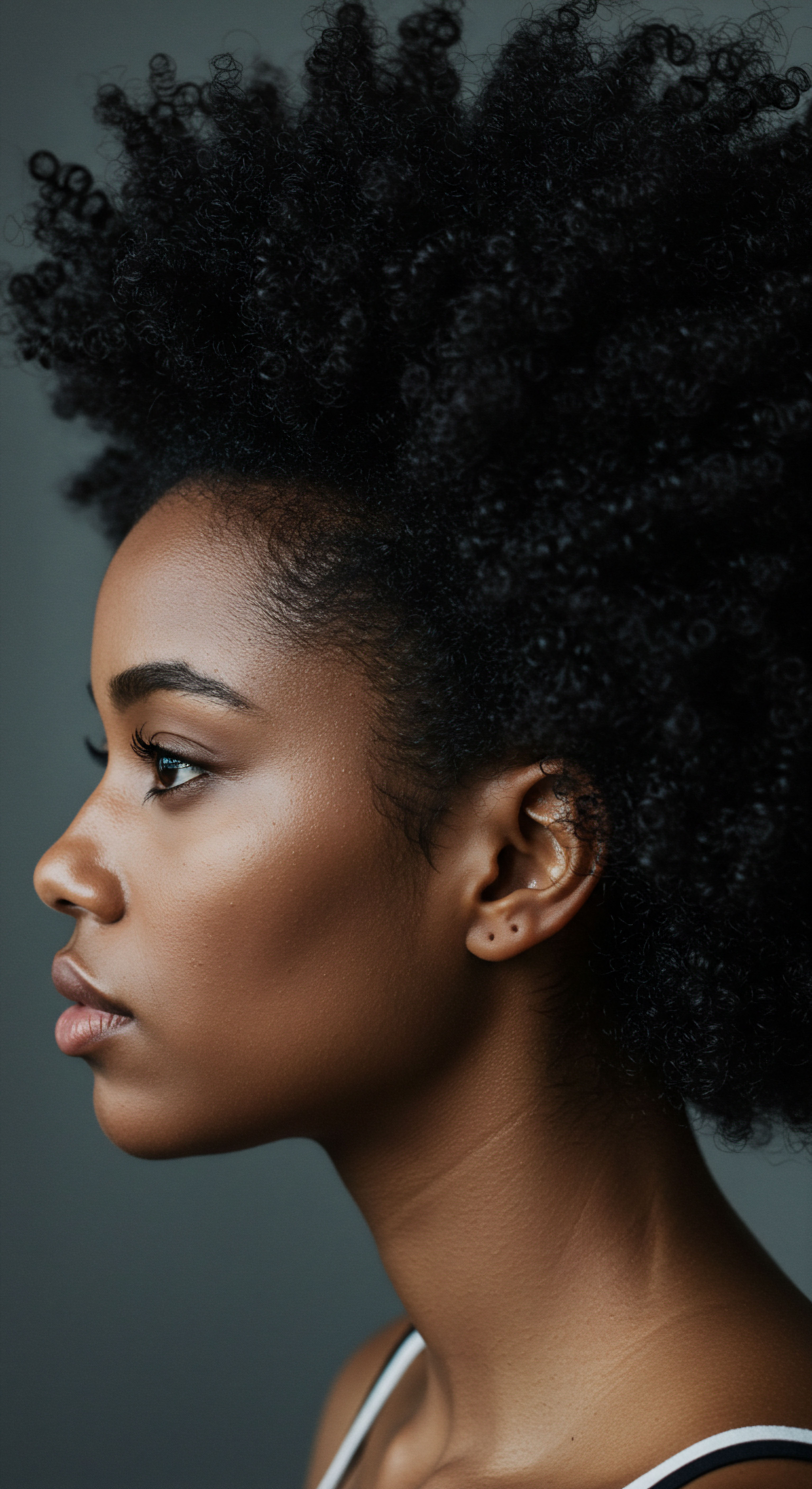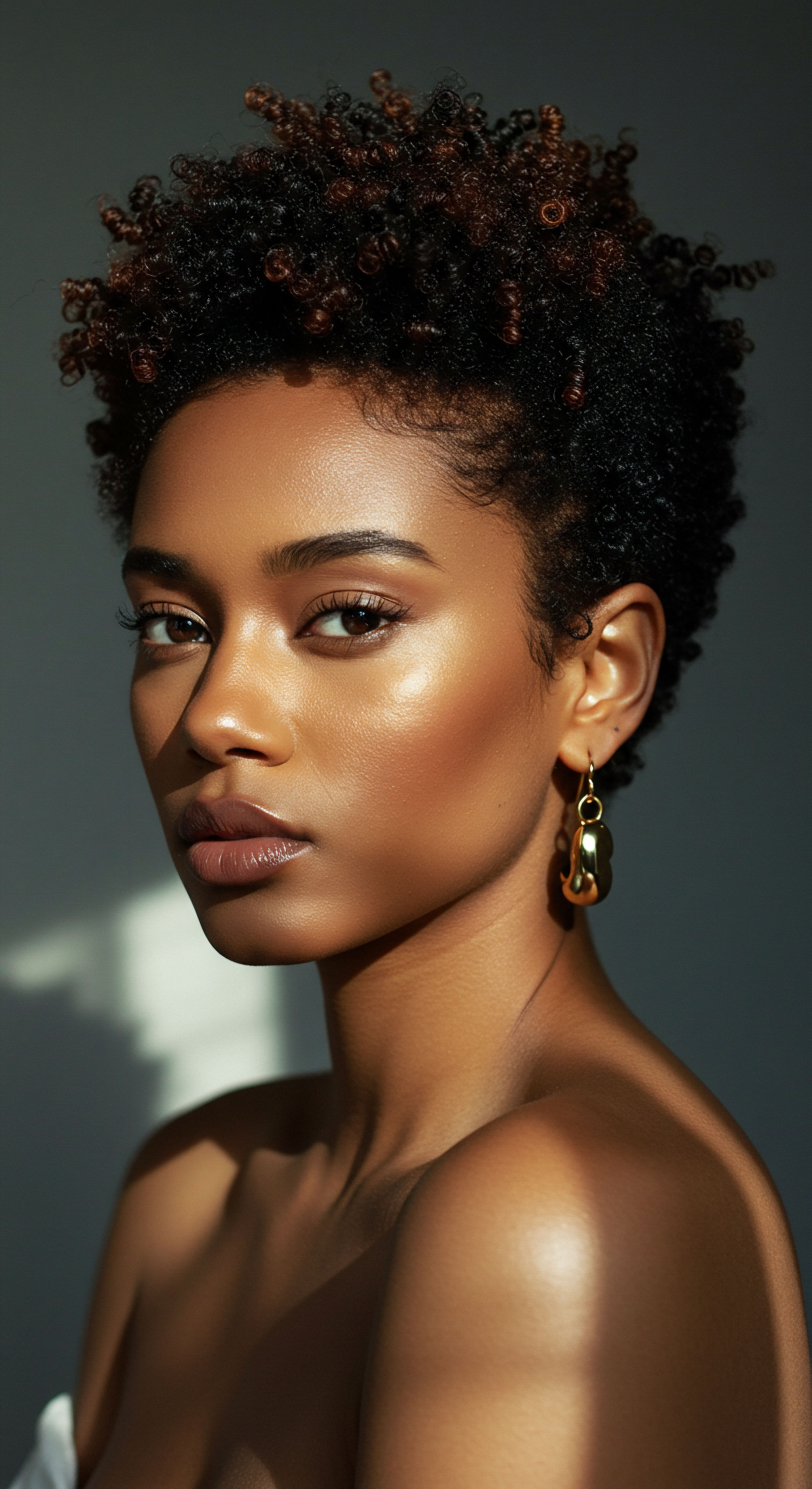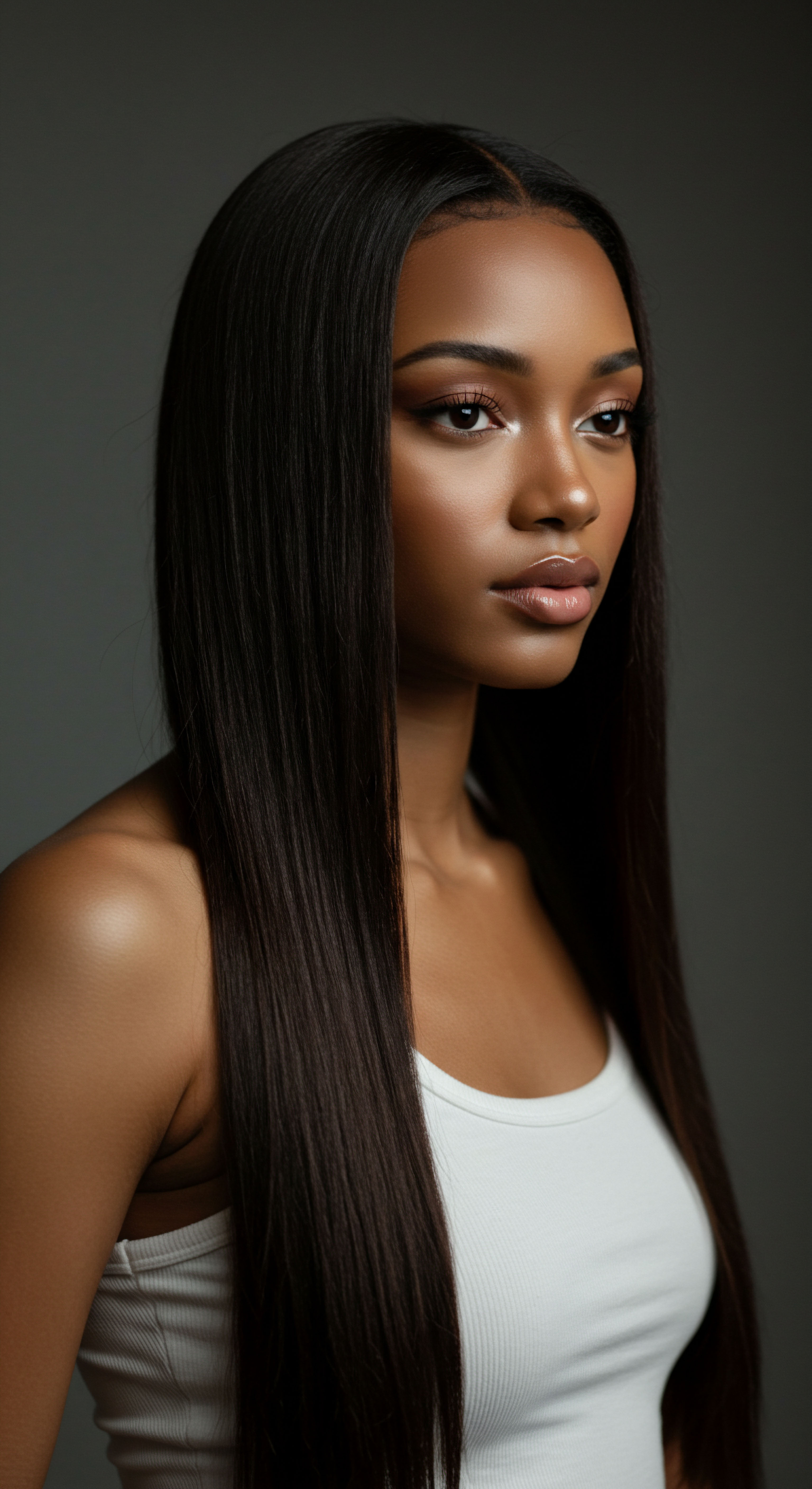
Roots
The quiet moments before slumber, when the world settles into its hushed rhythm, have long held a special place in human custom. Within these moments, for generations across varied cultures, a particular ritual has unfolded ❉ the covering of hair for the night. This practice, often seen today as a simple act of hair care, carries a profound weight of history, intertwining deeply with ancestral wisdom, cultural identity, and the very essence of well-being.
To understand why so many have, for so long, chosen to shroud their tresses as dusk descends, we must look beyond the immediate and consider the foundational elements that shaped such traditions. It is a journey into the practicalities of preservation, the sacredness of self, and the communal echoes of shared heritage.

The Ancient Call of Preservation
Consider the earliest human settlements, where life was intimately connected to the elements. Hair, particularly long or textured hair, was a constant companion, yet also vulnerable to the day’s dust, debris, and the rigors of labor. Nighttime offered a reprieve, a chance to shield hair from the environment and maintain its condition. This protective impulse, born of necessity, laid the groundwork for countless practices.
From the harsh desert winds of ancient Egypt to the humid climes of West Africa, a common thread of safeguarding hair emerged. Egyptian women, for instance, often wore elaborate wigs and head coverings, not merely for adornment but for protection against the sun and sand, extending this care into the night hours.
The materials chosen for these coverings were often those that offered the most gentle defense. Early forms of headwraps and bonnets, crafted from natural fibers, served to mitigate friction and preserve moisture, concerns that remain central to hair health today. This early understanding of hair’s delicate nature, passed down through generations, became a quiet cornerstone of ancestral wisdom.
Ancient wisdom often reveals itself in practices that, while seemingly simple, carry layers of practical and cultural significance.

Hair as Identity and Status
Beyond mere protection, hair held immense symbolic value across diverse ancient societies. It communicated a person’s social standing, marital status, age, and even tribal affiliation. To preserve these visual markers, especially during sleep, became a way to maintain one’s place within the community and honor one’s lineage.
- Social Standing ❉ In many African communities, intricate braiding patterns and styles could signify wealth or leadership.
- Marital Status ❉ Specific hairstyles might indicate a woman’s readiness for marriage or her married state.
- Tribal Affiliation ❉ Distinctive hair art could immediately identify one’s tribe or clan.
For example, in various African cultures, braids were not simply aesthetic choices; they were a visual language, conveying complex messages about heritage and identity. Preserving these intricate styles overnight meant preserving these messages, ensuring they could be presented anew each day. The act of covering hair at night, therefore, was not just about physical protection, but about upholding a visible narrative of self and community.
The practice of hair covering at night is a testament to the profound connection between physical care and cultural meaning, echoing a time when every aspect of one’s appearance held deep communal resonance.

Ritual
Stepping into the realm of ritual, we move beyond the foundational impulses to the deliberate, often comforting, practices that have shaped how hair is cared for during the hours of rest. The choice to cover hair at night, far from being a mere afterthought, evolved into a conscious act, a gentle ceremony performed with purpose and intention. This section considers the practical wisdom embedded in these nighttime customs, highlighting how they served both the physical needs of the hair and the deeper, often unspoken, needs of the individual. It is about understanding the applied knowledge that has sustained these practices through generations.

Why Protect Hair from the Night’s Friction?
The physical reality of sleep involves movement. Tossing and turning, even subtly, creates friction between hair strands and bedding materials. Cotton pillowcases, ubiquitous in many modern homes, can be particularly abrasive.
Their fibers, while soft to the touch, can snag and pull at the hair cuticle, leading to dryness, frizz, and breakage. Ancestral communities, perhaps through observation and generations of shared experience, understood this vulnerability.
The introduction of smooth materials like silk and satin into hair coverings was a practical innovation. These materials allow hair to glide rather than snag, significantly reducing friction. This simple material choice speaks volumes about an inherited understanding of hair’s delicate structure and the need for its gentle treatment, especially during extended periods of rest.
A 2020 study, examining factors related to female pattern hair loss, found a correlation between poorer sleep quality and an increased rate of hair loss among over 1,800 participants. While not directly attributing hair loss to sleep position or friction, this research underscores the broader link between restorative sleep environments and hair health, suggesting that practices which promote undisturbed hair during sleep could indirectly support overall hair vitality.

How Do Coverings Maintain Moisture?
Hair, especially textured hair, is prone to moisture loss. Dry environments, whether from indoor heating or arid climates, can strip hair of its natural hydration, leaving it brittle and susceptible to damage. Nighttime coverings serve as a crucial barrier, helping to seal in the hair’s natural oils and any applied moisturizers. This retention of hydration is paramount for maintaining elasticity and preventing breakage.
Consider the various forms of night coverings:
- Bonnets ❉ Often made of satin or silk, these provide a secure, friction-free enclosure for the hair, helping to retain moisture and preserve hairstyles.
- Headwraps and Scarves ❉ Historically and presently, these versatile coverings offer similar benefits, allowing for varied styling while still protecting the hair.
- Braids and Twists ❉ Even without an external covering, braiding or twisting hair before sleep can reduce tangling and minimize exposure to friction, effectively acting as an internal protective measure.
The quiet act of covering hair at night became a conscious, gentle ritual, reflecting an inherited understanding of hair’s delicate needs.
This intentional act of wrapping hair at night, often paired with the application of oils or balms, speaks to a deep, practical knowledge of hair biology, long before modern science articulated the mechanisms of moisture retention or cuticle health. It is a testament to the wisdom passed down through observation and lived experience.

Relay
Moving into the deeper currents of history and cultural understanding, we perceive that the act of covering hair at night is far more than a simple cosmetic choice. It is a profound practice, carrying echoes of social hierarchy, spiritual reverence, and even silent acts of resistance. This exploration transcends the immediate practicalities, inviting a more intricate look at how human experience, scientific understanding, and communal memory intertwine to shape such enduring customs. We consider the less apparent complexities, drawing on scholarship and data to reveal the layers of meaning beneath this seemingly straightforward habit.

What Historical Oppressions Influenced Hair Covering?
The story of hair covering, particularly for Black women, is inextricably linked to periods of profound oppression and resilience. During the transatlantic slave trade, enslaved Africans were often stripped of their traditional hairstyles, a deliberate act intended to erase their cultural identity and humanity. In some regions, laws were enacted, such as the Tignon Law in Louisiana, which mandated that Black women cover their hair, specifically to diminish their perceived attractiveness and social standing.
Yet, even within these oppressive frameworks, hair coverings became a subtle yet powerful form of resistance. Enslaved women used headwraps to communicate coded messages, even concealing rice and seeds within their braids as a means of survival and planning escape routes. Post-slavery, the stigma associated with head coverings persisted, often reinforced by caricatures like Aunt Jemima, which associated bonnets with servitude.
Despite this, the bonnet endured as a practical tool for hair maintenance, especially for textured hair, and eventually, as a symbol of Black resistance and self-care. This complex history highlights how a seemingly simple accessory can bear the weight of both subjugation and defiant cultural continuity.

Does Hair Covering Relate to Sleep Quality and Health?
Beyond the tangible benefits of preventing friction and retaining moisture, contemporary research sheds light on the subtle ways hair health and sleep intertwine, lending a modern scientific lens to ancestral practices. The connection between sleep quality and overall well-being, including hair and scalp health, is increasingly acknowledged. A 2025 study utilizing the Hair & Scalp CARE questionnaire found a significant association between healthier hair and scalp and lower levels of perceived stress and good sleep health.
While this research does not directly address hair covering, it suggests that practices which contribute to a sense of hair health and comfort could indirectly support improved sleep quality. When hair is protected from tangling, dryness, and breakage overnight, it can lead to less discomfort upon waking and a more serene morning routine, potentially reducing daily stressors related to hair management.
| Motivation Protection |
| Historical Context Shielding from environmental elements, dust, and physical damage during sleep. |
| Contemporary Scientific Insight Reduces friction against bedding, minimizing breakage, split ends, and frizz. Preserves moisture balance. |
| Motivation Cultural Significance |
| Historical Context Maintaining hairstyles that denote status, marital state, or tribal identity. |
| Contemporary Scientific Insight Continues as a practice of self-care, cultural pride, and a connection to heritage, especially within the African diaspora. |
| Motivation Hygiene |
| Historical Context Keeping hair clean and contained, particularly in less sanitary conditions. |
| Contemporary Scientific Insight Prevents product transfer to bedding, helps maintain cleanliness of styles, and reduces tangling. |
The ancestral impulse to cover hair at night, therefore, was not merely a superficial act. It was a practice rooted in a sophisticated, if unarticulated, understanding of hair’s physical vulnerabilities, its deep social meaning, and its connection to overall well-being. These layers of purpose, passed down through generations, continue to resonate in modern hair care practices, demonstrating the enduring wisdom of our forebears.
Hair coverings represent a deep cultural and scientific interplay, protecting strands while affirming identity.

How Did Spirituality Influence Hair Practices?
For many ancient cultures, hair was more than just a physical attribute; it was seen as a conduit for spiritual energy, a connection to the divine, or a repository of one’s essence. To leave hair uncovered, especially during the vulnerable hours of sleep, could be perceived as exposing oneself to negative influences or a disregard for its sacred nature.
In Yoruba cosmology, for instance, hair is considered sacred, acting as a medium that connects individuals to their ancestors and deities. Practices like hair oiling, found in Ayurvedic traditions dating back thousands of years, were not just for physical nourishment but also held spiritual significance, believed to promote relaxation and stress relief. The act of covering hair at night, after such nourishing rituals, would serve to seal in these benefits, both physical and spiritual, and protect this vital connection. This holistic view of hair, as something deeply intertwined with one’s spiritual self, provided another compelling reason for its careful protection during the night.

Reflection
The quiet act of covering hair at night, a practice seemingly simple, holds within its folds a profound testament to human ingenuity, cultural perseverance, and an enduring connection to self. From the ancient desire to protect delicate strands against the elements and the rigors of daily life, to the deep symbolic meanings of identity and status, and even as a quiet act of resistance against oppression, this custom has journeyed through time, adapting and enduring. The smooth glide of silk, the gentle embrace of a bonnet, or the careful arrangement of braids before slumber—each speaks to a timeless wisdom that recognizes hair as more than mere fiber.
It is a crown, a connection to lineage, a canvas of personal and communal story. As we continue to seek balance in our modern lives, these ancestral rhythms of care offer a gentle reminder ❉ that true well-being often lies in honoring the small, deliberate acts that nourish us, body and spirit, as the world drifts to sleep.

References
- 1. Donaldson, Star. The Significance and History of Bonnets. Byrdie, 2022.
- 2. Helix Hair Labs. The History of the Hair Bonnet. Helix Hair Labs, 2023.
- 3. The Silk Collection. Benefits of Silk Hair Wrap for Sleeping. The Silk Collection.
- 4. Esme Luxury. Silk Hair Wraps in Different Cultures ❉ A Global Perspective. Esme Luxury, 2024.
- 5. Cee Cee’s Closet NYC. The History of Bonnets. Cee Cee’s Closet NYC, 2021.
- 6. Wikipedia. Bonnet (headgear). Wikipedia.
- 7. Healthline. How to Sleep with Long Hair to Protect the Health of Your Hair. Healthline, 2021.
- 8. The History and Evolution of Hair Bonnets ❉ From Traditional to Modern Styles. 2024.
- 9. Royaltee Magazine. Braids, Plaits, Locs ❉ The History of Black Protective Hairstyles. Royaltee Magazine, 2021.
- 10. Fulham Scalp And Hair Clinic. Protective Styling For Afro-Textured Hair. Fulham Scalp And Hair Clinic, 2024.
- 11. DigitalCommons@Fairfield. A Cultural History of Hair in Antiquity. DigitalCommons@Fairfield.
- 12. Afriklens. African Hairstyles ❉ Cultural Significance and Legacy. Afriklens, 2024.
- 13. The Purple Pulse. Protective hairstyles hold cultural significance. The Purple Pulse, 2024.
- 14. HairClub. A Brief History of Hair ❉ Identity, Self-Expression & the Impact of Hair Loss. HairClub.
- 15. OrganiGrowHairCo. Protecting Your Hair from Environmental Damage. OrganiGrowHairCo, 2024.
- 16. Umthi. The Cultural Significance and Representation of Afro-Textured Hair. Umthi, 2023.
- 17. Afriklens. Natural African Haircare ❉ Celebrating the Afro and Braids. Afriklens, 2024.
- 18. Annie International, Inc. The Origin Story Of The Bonnet. Annie International, Inc. 2023.
- 19. The Ultimate Guide to Hair Bonnets ❉ Everything You Need to Know. 2023.
- 20. Flora & Curl. The History Of Black Hairstyles. Flora & Curl.
- 21. JSTOR Daily. Hair, Gender, and Social Status in Ancient Egypt. JSTOR Daily, 2020.
- 22. Allegra. The Fascinating History of the Bonnet, a Unique Headpiece. Allegra.
- 23. YANIBEST. The Satin Bonnet ❉ Embracing History, Beauty, and Diversity. YANIBEST, 2024.
- 24. Kodd Magazine. African hair tells a story and inspires the future. Kodd Magazine.
- 25. National Hair & Beauty Federation. The Evolution of Hairstyles ❉ A Journey Through Time. National Hair & Beauty Federation.
- 26. Byrdie. The History Of Bantu Knots Is Important To Know. Byrdie, 2022.
- 27. The History and Cultural Significance of African Hair Braiding. 2023.
- 28. Fabulive. Cultural Significance of Hair Through Time. Fabulive.
- 29. Treatment Rooms London. Can A Lack of Sleep Cause Hair Loss?. Treatment Rooms London, 2024.
- 30. African American Museum of Iowa. History of Hair. African American Museum of Iowa.
- 31. Brown History. The Bonding Ritual of Hair Oiling. Brown History, 2023.
- 32. Contemporary African-American Hair Care Practices. 2015.
- 33. Wikipedia. Protective hairstyle. Wikipedia.
- 34. emma plus three. ANCIENT HAIR RITUALS FOR THE MODERN WOMAN. emma plus three, 2023.
- 35. Good Health by Hims. Does Lack of Sleep Cause Hair Loss?. Good Health by Hims, 2024.
- 36. Sleep masks for hair care ❉ prevent breakage and control frizz.
- 37. Shaz & Kiks. How Braids Protect Your Hair While You Sleep. Shaz & Kiks, 2020.
- 38. a-saloon. Hair Care ❉ How to protect your hair while sleeping. a-saloon.
- 39. Clinikally. Impact of Sleep Deprivation on Hair Health. Clinikally, 2024.
- 40. Afro Hair Care – The Ultimate Guide for 2022. 2022.
- 41. Reddit. People of other cultures wearing bonnets ❉ r/Naturalhair. Reddit, 2024.
- 42. 3 tips to protect your hair from damage while you sleep.
- 43. Glasshouse Salon. Ancient Beauty Rituals. Glasshouse Salon.
- 44. Daughters of Flowers. Ritual Hair Rinsing. Daughters of Flowers, 2024.
- 45. Sleep.com. How a Hair Wrap Routine Protects More Than Just My Hair. Sleep.com, 2021.
- 46. African Pride. 8 Ways to Protect Your Natural Hair at Night. African Pride.
- 47. Well+Good. I Tried 3 Ancient Beauty Rituals That Outperformed My Favorite Modern Hair and Skin-Care Products. Well+Good, 2023.
- 48. HCPLive. Hair, Scalp Health Linked to Perceived Stress and Sleep Quality. HCPLive, 2025.
- 49. Journal of Sleep Sciences. The Quality of Sleep and Quality of Life in Patients with Alopecia. Journal of Sleep Sciences.